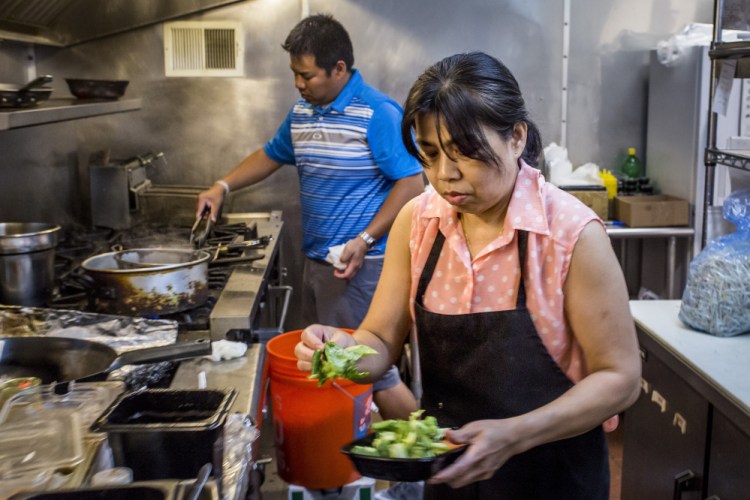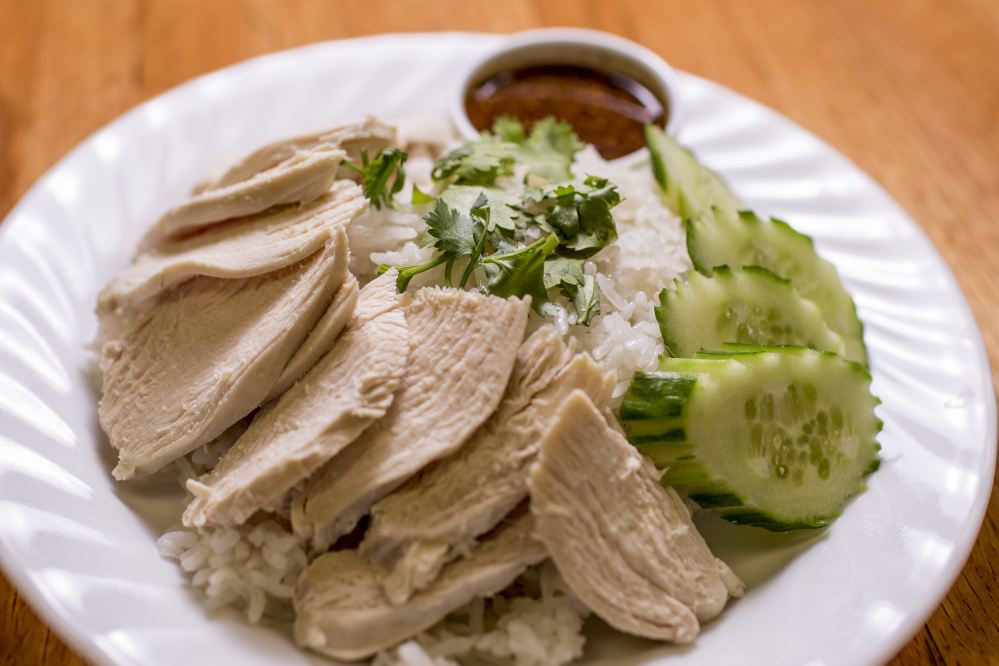In Singapore, there is hawker stall (a sort of stationary food cart) famous all over Asia for its Hainanese Chicken Rice, a simple-looking plate of white rice, pale poached chicken, a few vegetables and a potent chili sauce. It’s a stealth dish whose glory hides in plain sight. If you were to judge Chicken Rice based on how it looks, you’d never give a second thought – most tourists don’t. But take just one bite of the ginger-and-garlic infused meat, the rice that coyly reveals to you that it has been bathed in chicken fat, the layered, umami-rich heat of the sauce, and you immediately comprehend why this is one of the culinary wonders of the world.
I will always remember visiting Singapore for the first time, when I took my place at 10 a.m. in a quarter-mile long line for that same hawker stall, already aware that every single day, it sold out just half-an-hour after opening. Ahead of me were peckish office workers and “stand-ins,” who had been paid to wait in the line – some stood there four or five days each week. Luckily, I got one of the very last portions of the day and ate sitting on a concrete bench, steaming plate in hand, telling myself to enjoy it, because I would never taste another Chicken Rice as fantastic as what I was eating then.
But Siwaporn Roberts, chef and co-owner of Thai Esaan, proved me wrong.
At her pint-sized restaurant on Forest Avenue in Portland, Roberts serves the Thai version of Chicken Rice, khao mun gai ($12), with a thick, vibrant sauce full of hot chilies, fermented soybean paste, sweet soy sauce and a little fish sauce, alongside decadent mounds of aromatic rice and slices of unbelievably moist chicken breast. “Most restaurants don’t make khao mun gai because it’s too difficult,” she told me, “but I wanted to make it for people who like to try new, different foods.”
Indeed, Thai Esaan’s extraordinary khao mun gai is a perfect introduction to the cuisine of northeastern Thailand – the region that gives the mostly take-out restaurant its name. Cradled between Laos and Cambodia and known for dishes that focus on spicy heat, sticky rice and flamboyantly herbal ground meat salads (laabs), Esaan is a rural part of the country with no major international city. If you’ve never heard of it, you’ve got plenty of company.
Over the past 20 years though, the region’s cooking has spread, first through Thailand’s big cities, out into Asia, and then to the United States, where a few celebrated chefs have borrowed northeastern Thai recipes and served them to great acclaim. Roberts’ recipes, on the other hand, are all her own, refined in tandem with her mother throughout their 15 years cooking in local restaurants. “They worked at a few places in Maine and tried to share their recipes, but they always left because the owners changed things too much. The food wasn’t right,” Ben Boonseng, the general manager (and Roberts’ son) said. “My mom wanted to open her own restaurant where we shop for fresh ingredients every morning, and she can focus on quality because she cooks it all.”
Left to her own devices, Roberts is able to do justice to classics like green papaya salad ($8), a dish of shredded unripe papaya, green beans, tomatoes and peanuts, all doused in a spicy, sour fish-sauce dressing. Elsewhere, you might find a version made by just tossing the components together in a bowl, but at Thai Esaan, Roberts develops tremendous flavor by roughing up the ingredients by hand with a light pounding in a large stone mortar and pestle.
Freedom to choose her own menu also gives her the chance to present dishes rarely found at other Thai restaurants in this country. One example is the street food dish, ba mee ($8 and $10, depending on choice of protein), a bowl of supple egg noodles and wontons coated with a pork-and-garlic sauce, and served either with or without a brawny, anise-scented broth. Think of ba mee as ramen’s much bolder, raunchier fraternal twin, but the sibling you secretly like better.
It’s hard to choose a favorite among the regional Esaan specialties, with options like the superb laab gai ($10), a salad of tender ground chicken, red onion and carrot, marinated in a bracing dressing of mint, cilantro, lime juice and sticky toasted rice powder. Or kanaa moo grob ($12) Chinese broccoli, thin carrot discs and crispy strips of fried pork shoulder sautéed in a sweet, mellow sauce made from soy and mild chilies.
Introducing uncommon Esaan dishes to an unfamiliar public has required a few accommodations for American tastes, like the substitution of pork shoulder for pork belly (too fatty) in the kanaa moo grob, or the inclusion of chicken breast in the khao mun gai rather than cleavered chunks of whole poached chicken (too much skin). Yet rather than diminishing her, making compromises seems to have brought a clarity of flavor and preparation to Roberts’ cooking, forcing her to spotlight northeastern Thai spicing and technique.
But beware: you’ll miss the best part of the show if you treat Thai Esaan like any other take-out joint. Sure, the pad Thai ($8/$10) and green curry ($8/$10) are very respectable, even great, versions of old standbys and will not disappoint, but they aren’t what makes this restaurant so exceptional. They are simply the dishes that a Thai restaurant must serve in order to survive.
Boonseng and Roberts understand that even though they have to make a few allowances for diners to catch up with them, their little eight-seat restaurant is unique. “There are a lot of Thai places here, but we are doing something totally different. We don’t really have any competition in Portland. It’s just us,” Boonseng said.
Frankly, it would be easy to drive right past clean yet unassuming little Thai Esaan if you only looked at its exterior – exactly the way so many tourists ignore Chicken Rice because it doesn’t broadcast its special qualities in a garish peacock display. But if you do that, you will miss some of the area’s most exciting cooking, the kind of food that is not only worth a special trip, but worth remembering later.
Andrew Ross has written about food in the United Kingdom and in New York, where he co-founded NYCnosh, a food website. He and his work have been featured on Martha Stewart Living Radio and in The New York Times. He is an Internet researcher and higher education consultant. Contact him at:
Twitter: @AndrewRossME
Send questions/comments to the editors.




Comments are no longer available on this story